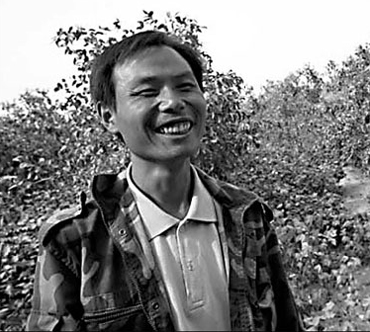Tired of the boring yellow of the sand and the silver of saline soil, the eyes get some relief in the fields of relaxing green in the Pimo area, where the 14th division of the Xinjiang Production and Construction Group is situated.
Pimo, situated to the south of the Taklamakan Desert in the Xinjiang Uygur Autonomous Region, is located in the junction of two neighboring counties - Pishan and Moyu.
Until 2002, the area was a complete desert. A green campaign to build a 200-sq km oasis in the desert began in September 2002.
To ensure the survival of the oasis, the constructors planted a forest band around the planned area.
It generally takes one year for samplings to grow. Before they are fully grown, the young trees cannot withstand the strong desert sandstorms.
The first crop of seedlings withered in 2003, and the second crop met with the same doomed fate the following year.
But the constructors did not lose hope and patience. Their continued green efforts paid off when they planted a third crop of seedlings in 2004.
In the face of their unflagging patience, nature may have had to give in. The third crop got the opportunity to extend their roots deep into the soil and finally survived.
With 100 sq km of developed land so far, Pimo has been transformed from a desert landscape into an artificial oasis with a thick coverage of forests and grassland, setting up a line of green defense against desert invasion.
Local authorities are revving up efforts to build the oasis, pushing the green arc to shoulder its way into the desert. They have imported a set of irrigation pipe network from Israel and diverted water through a 50-km-long channel from a reservoir in upstream Kaxgar River, south of the Kunlun Mountain.
A worker in a date orchard of Xinjiang shows optimism about his crop harvest. Over five years of green efforts, the Xinjiang Production and Construction Group has transformed Pimo from a 200-sq km desert into a thriving oasis.
Forestry and fruit sectors are the focus of the area's economy. At present, Pimo has 40 sq km under date and peach cultivation.
Branchy Tarmarisk, a kind of short bush known for its strong defense against sandstorms, is a common plant in Pimo's city planning.
Another desert plant widespread in the area is the Cistanche, which is used in traditional Chinese medicine.
Growing the Cistanche, the parasitic specie of an economic value together with the Branchy Tarmarisk, which has environmental value, is the result of a plan devised by the locals that has exerted influence in improving the environment while increasing their incomes. Pimo's gross domestic product reached 25.55 million yuan in 2006.
(China Daily December 28, 2007)







